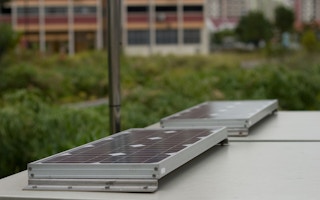Solar energy, which makes up less than 1 per cent of SIngapore’s energy generation today, could account for five per cent of its energy needs by 2025, a small but important contribution that will help the city state reduce fossil fuel use, carbon emissions and increase energy security.
To continue reading, subscribe to Eco‑Business.
There's something for everyone. We offer a range of subscription plans.
- Access our stories and receive our Insights Weekly newsletter with the free EB Member plan.
- Unlock unlimited access to our content and archive with EB Circle.
- Publish your content with EB Premium.
But unlocking these benefits will require the government to implement policies that make solar more economically attractive and help the industry overcome technical barriers such as managing the variable nature of solar energy, said Christophe Inglin, managing director of homegrown solar firm Phoenix Solar on Thursday.
Speaking at a conference on the future of solar PV in Singapore organised by the National University of Singapore’s Energy Studies Institute (ESI), Inglin told the audience of about 80 guests that Singapore could see two gigawatts peak (GWp) of solar energy installed by 2025, according to projections by the Sustainable Energy Association of Singapore.
But as the adoption of solar continues to expand rapidly both in Singapore and globally, managing the intermittent and variable nature of solar energy - which is only generated by solar panels when sunlight is available - remains a key challenge that needs to be overcome, said Inglin.
One way is to store the solar energy that is generated in the daytime in batteries, and use it at night to offset the cost of electricity from the grid.
But this is a relatively expensive and inefficient process, said Inglin. Instead, he had an idea for a solution from an unlikely source: electric vehicles.
The batteries of electric vehicles (EVs) - cars which are gaining popularity among consumers globally - could help to mitigate the intermittent supply of solar energy and help keep the energy grid stable, shared Inglin.
“Private cars are parked for 94 per cent of the time,” said Inglin. It’s during this time that it’s possible for the car’s battery to exchange power with the electrical grid, he added.
Excess solar energy from rooftop systems could be stored in the battery, and could be fed back into the energy system when a car is parked and connected to the grid, he explained.
In such a system, owners of EVs could be paid by grid operators for the energy they provide to the grid, or renting out their batteries as storage.
These possibilities have not been extensively explored globally as EVs are a relatively new phenomenon, and are not even widely available in Singapore, said Inglin. But his idea was especially promising for Singapore because EVs are ideal for urban driving, he added.
Singapore, and other densely packed urban environments, are considered especially well-suited to EVs for many reasons: shorter distances ease ‘range anxiety’ of EV drivers who worry they will run out of charge before reaching their destination; driving on urban roads often requires more frequent braking, which is how EVs generate electricity; and the lack of emissions from EV tail-pipes helps mitigate air pollution in cities.
“
Imagination is the limit to what business models are possible.
Christophe Inglin, managing director, Phoenix Solar
When the market for EVs matures in the city state, stakeholders in the clean energy industry are likely to look for innovative solutions to help make EVs a part of the energy grid. Developing these creative ideas will require regulations around EVs to be eased, he noted.
“Imagination is the limit to what business models are possible,” he said.
Experts at the conference, held at Hotel Jen, added that beyond Singapore, solar energy is playing a key role in helping curb carbon emissions and achieving a more sustainable energy system globally.
Michael Waldron, renewable energy senior analyst at the International Energy Agency (IEA), shared that in order to confine global temperature rise to two degrees Celsius - the limit recommended by scientists to avoid dangerous climate change - renewables would need to account for at least 65 per cent of global energy generation by 2050, up from 20 per cent today.
Solar photovoltaic (PV) power, which has seen increasing adoption worldwide as costs fall, could make up 16 per cent of global electricity by 2050, but realising the potential of this increasingly competitive technology “depends on the evolution of cost and policy debates in a number of markets,” said Waldron.
Governments would need to set long-term targets on scaling up solar energy, introduce predictable future policies to inspire confidence among investors, and develop markets with fair rules and payment mechanisms for both residential and commercial PV installations, he said.
“There is still a lot of work to be done and progress that needs to be made in a number of markets” before renewables can reach the scale needed to adequately mitigate climate change”, he said.










